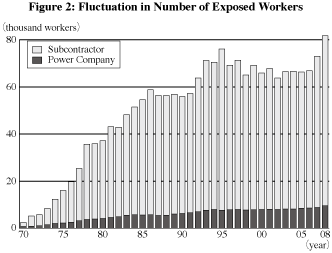Workers’ Radiation Exposure Data for FY2008
On July 16 the Nuclear Industrial and Safety Agency (NISA) released its 2008 Fiscal Year (April 2008 to March 2009) report on radiation exposure incurred by people working at nuclear power plants, fuel cycle facilities and radioactive waste facilities and the current status of radioactive waste management. Figure 1 andFigure 2 show the fluctuation in worker exposure at commercial nuclear power plants over the past three decades.
The total collective dose in FY 2008 for people working at nuclear power plants was 84.04 person sieverts, an increase of 5.86 person sieverts compared to the previous year. Radiation exposure of subcontractor workers accounts for over 96% of the total dose.
The greatest increase was 3.1 person sieverts at the Kashiwazaki-Kariwa Nuclear Power Station. Since the Chuetsu-oki Earthquake in July 2007 all sorts of equipment problems have been found. We presume that the increased radiation exposure was incurred during inspection and repair work related to these problems.
The 256 people who received radiation doses in the 15-20 milli-sievert range were all subcontractor workers. The highest individual dose was 19.5 milli-sieverts at the Takahama Nuclear Power Station. The highest individual dose for an electric power company employee was 14.6 milli-sieverts at the Fukushima I Nuclear Power Station.
The data published by NISA does not take into account the fact that many people work at more than one site. According to the Radiation Dose Registration Center for Workers (Registration Center), which calculates the total dose received by individuals at all work places, one person who worked at 4 different sites received a total dose in the 20-25 milli-sievert range, while 531 people received doses in the 15-20 milli-sievert range.
Mikiko Watanabe (CNIC)




